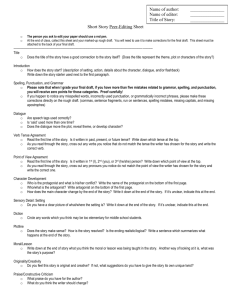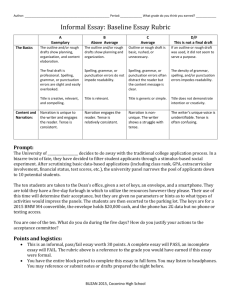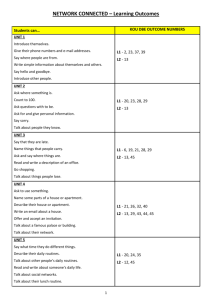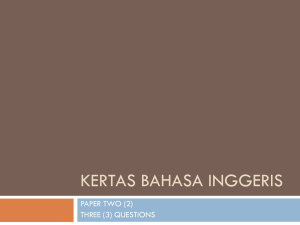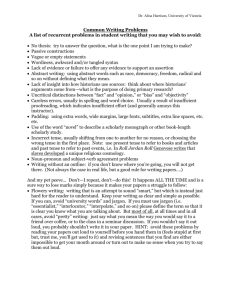Short Story Peer
advertisement
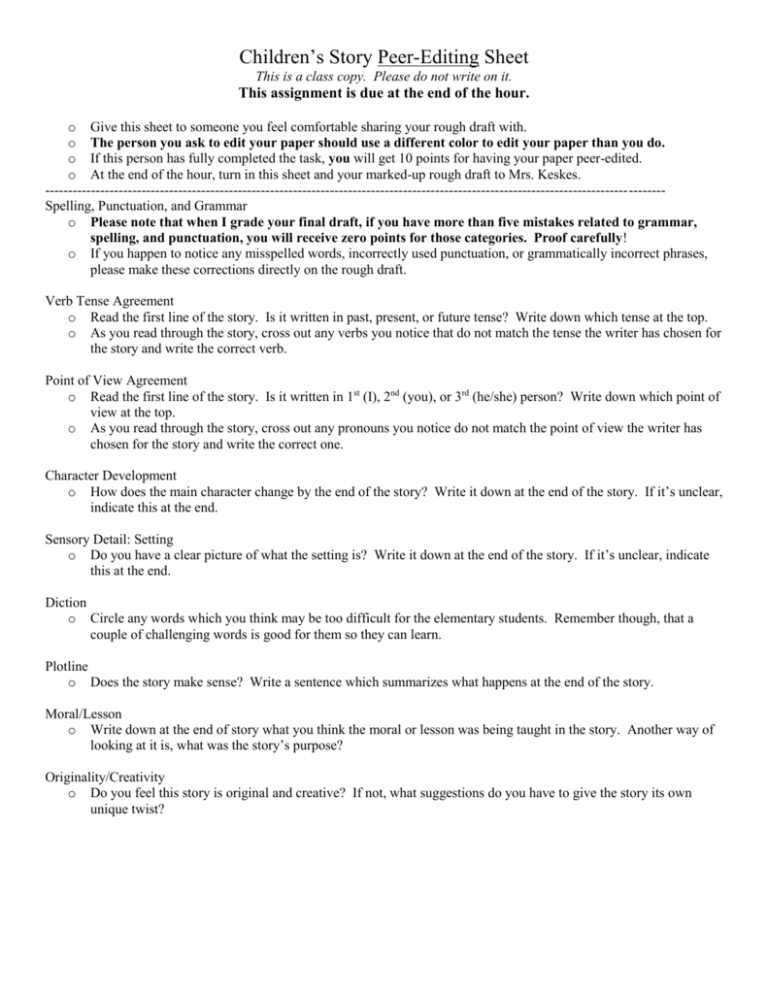
Children’s Story Peer-Editing Sheet This is a class copy. Please do not write on it. This assignment is due at the end of the hour. o Give this sheet to someone you feel comfortable sharing your rough draft with. o The person you ask to edit your paper should use a different color to edit your paper than you do. o If this person has fully completed the task, you will get 10 points for having your paper peer-edited. o At the end of the hour, turn in this sheet and your marked-up rough draft to Mrs. Keskes. --------------------------------------------------------------------------------------------------------------------------------------Spelling, Punctuation, and Grammar o Please note that when I grade your final draft, if you have more than five mistakes related to grammar, spelling, and punctuation, you will receive zero points for those categories. Proof carefully! o If you happen to notice any misspelled words, incorrectly used punctuation, or grammatically incorrect phrases, please make these corrections directly on the rough draft. Verb Tense Agreement o Read the first line of the story. Is it written in past, present, or future tense? Write down which tense at the top. o As you read through the story, cross out any verbs you notice that do not match the tense the writer has chosen for the story and write the correct verb. Point of View Agreement o Read the first line of the story. Is it written in 1st (I), 2nd (you), or 3rd (he/she) person? Write down which point of view at the top. o As you read through the story, cross out any pronouns you notice do not match the point of view the writer has chosen for the story and write the correct one. Character Development o How does the main character change by the end of the story? Write it down at the end of the story. If it’s unclear, indicate this at the end. Sensory Detail: Setting o Do you have a clear picture of what the setting is? Write it down at the end of the story. If it’s unclear, indicate this at the end. Diction o Circle any words which you think may be too difficult for the elementary students. Remember though, that a couple of challenging words is good for them so they can learn. Plotline o Does the story make sense? Write a sentence which summarizes what happens at the end of the story. Moral/Lesson o Write down at the end of story what you think the moral or lesson was being taught in the story. Another way of looking at it is, what was the story’s purpose? Originality/Creativity o Do you feel this story is original and creative? If not, what suggestions do you have to give the story its own unique twist? Children’s Story Self-Editing Sheet This is a class copy. Please do not write on it. This assignment is due at the end of the hour. o o o Use this sheet to help you edit and revise your rough draft. Use a color different from your peer editor to mark up the draft. If you have fully completed the task, you will get 10 points. At the end of the hour, turn in this sheet and your marked-up rough draft to Mrs. Keskes. -------------------------------------------------------------------------------------------------------------------------------------Spelling, Punctuation, and Grammar o Please note that when I grade your final draft, if you have more than five mistakes related to grammar, spelling, and punctuation, you will receive zero points for those categories. Proof carefully! In fairness to all students, Mrs. Keskes cannot be a peer editor. She will be proofing all final drafts before they are bound. o If you happen to notice any misspelled words, incorrectly used punctuation, or grammatically incorrect phrases, please make these corrections directly on the rough draft. Verb Tense Agreement As a writer, it’s your decision whether you choose to write in past, present, or even future tense, for your story. The issue is when you bounce back and forth between more than one tense. It’s a common mistake that can become really confusing for your reader. Activity: What tense are you using in your story? Write it at the top of your short story. Activity: Go back through your story now and correct any verbs you notice do not match the tense you have chosen to write your story in. Point of View Agreement As a writer, it’s your decision whether you choose to write in 1st, 2nd, or 3rd person for your story. The issue is when you bounce back and forth between points of view. Activity: What point of view are you using in your story? Write it at the top of your short story. Activity: Go back through your story now and correct any pronouns (I, you, he/she, us, etc..) you notice do not match the point of view you have chosen to write your story in. Dialogue Formatting (If your story doesn’t contain dialogue, you can skip this step). Dialogue can help make a story more interesting by revealing how the characters talk and interact with one another. It can be confusing though if not done correctly. Activity: Take out the handout Mrs. Keskes provided on Punctuating Dialogue Correctly. Use it as a guide to make corrections on your rough draft. Feel free to get your rough draft messy! Character Development Even though this is a children’s story, you still want to have characters who change as a result of the events in the story. This makes the story more interesting and relatable. Activity: At the top of your paper, write down how your character changes/what they learn. Underline where in the story your character undergoes change. Sensory Detail: Setting It’s important to be very clear on where your story takes place so your illustrator knows what to draw. Activity: Underline where in the story you mention the setting. Plotline It’s important that your story makes sense by following the basic plot structure. Activity: Create a plotline chart at the end of the story and label it with parts from your story. Quick Check If you answer no to any of the following questions, make sure you make a notation on your rough draft to fix the issue. o Does your story allow room for illustrations or do you envision the drawings on the backs of the pages? o Do you have a cover page with your name and title of the story? o Have you numbered your pages?
